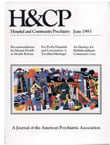Recidivism on an Acute Psychiatric Forensic Service
Abstract
Those who deliver mental health services to forensic patients should be aware that the revolving door exists on acute forensic units. Some of these units may view their near-exclusive mission as assessment of patients' competency to proceed through the judicial process. However, recognition that one-third of the patient population we studied were forensic unit recidivists and one-half of the population were severely psychiatrically disturbed suggests the need for more ambitious aims in forensic settings, including broaden psychosocial assessment, treatment, and linkage with continuing services.
Our data support the perception that the chronic mentally ill population is becoming entrenched in a fragmented system of treatment and incarceration. This state of affairs requires more skill by clinicians attempting to effect a semblance of continuity of care. Besides adopting a more comprehensive therapeutic approach on forensic units, workable legal remedies are needed to increase the chances that chronic mentally ill patients will receive adequate care. These remedies could include mandated jail and prison screening programs and case management systems, humane commitment laws, effective outpatient commitment statutes with postrelease monitoring, and conservatorship for gravely disabled persons (5-6,8,10).
Access content
To read the fulltext, please use one of the options below to sign in or purchase access.- Personal login
- Institutional Login
- Sign in via OpenAthens
- Register for access
-
Please login/register if you wish to pair your device and check access availability.
Not a subscriber?
PsychiatryOnline subscription options offer access to the DSM-5 library, books, journals, CME, and patient resources. This all-in-one virtual library provides psychiatrists and mental health professionals with key resources for diagnosis, treatment, research, and professional development.
Need more help? PsychiatryOnline Customer Service may be reached by emailing [email protected] or by calling 800-368-5777 (in the U.S.) or 703-907-7322 (outside the U.S.).



